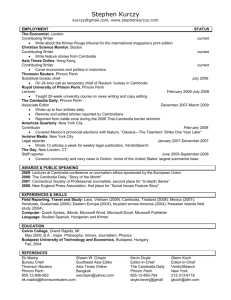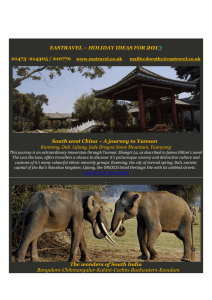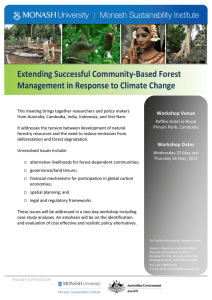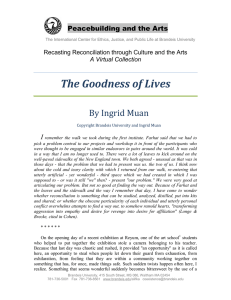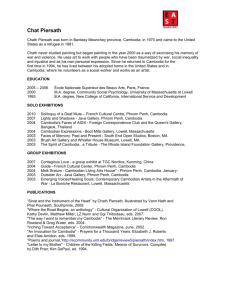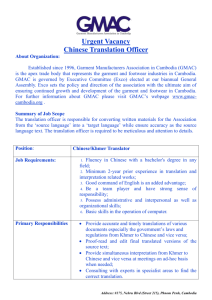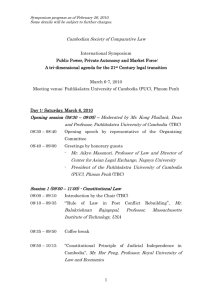The Goodness of Lives Ingrid Muan by
advertisement
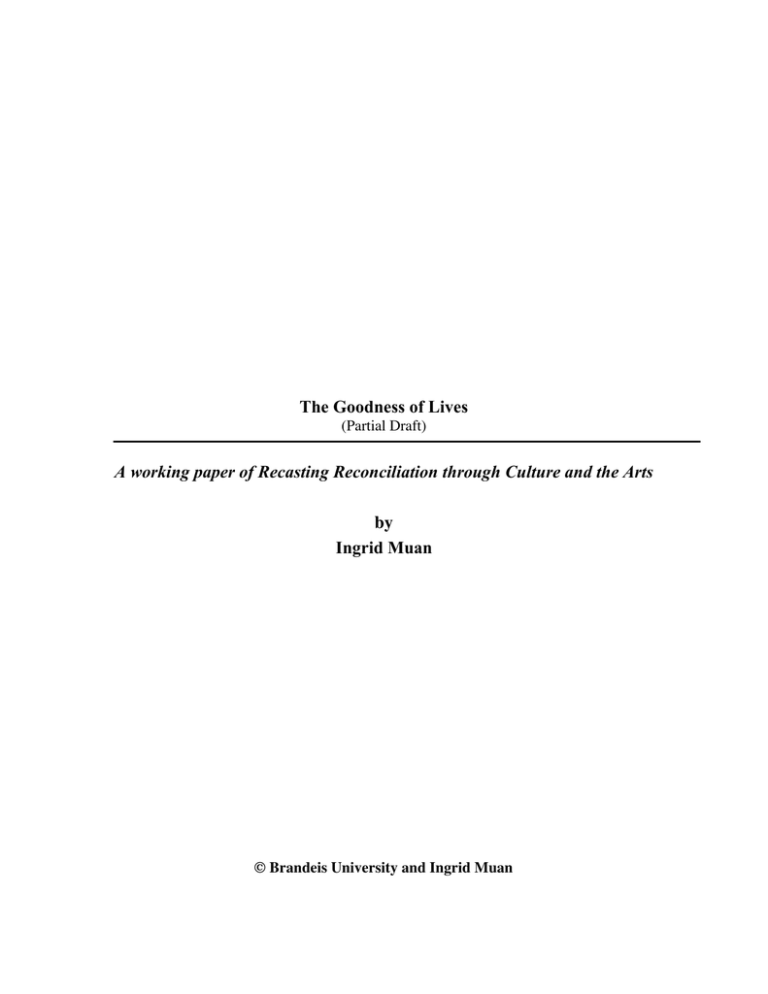
The Goodness of Lives (Partial Draft) A working paper of Recasting Reconciliation through Culture and the Arts by Ingrid Muan © Brandeis University and Ingrid Muan The Goodness of Lives (A Partial Draft1) Ingrid Muan I remember the walk we took during the first institute. Farhat said that we had to pick a problem central to our projects and workshop it in front of the participants who were thought to be engaged in similar endeavors in pairs around the world. It was cold in a way that I am no longer used to. There were a lot of leaves to kick around on the wellpaved sidewalks of the New England town. We both agreed - unusual as that was in those days - that the problem that we had to present was us. The two of us. I think now about the cold and teary clarity with which I returned from our walk, re-entering that utterly artificial - yet wonderful - third space which we had created in which I was supposed to or was it still "we" then? - present "our problem." We were very good at articulating our problem. But not so good at finding the way out. Because of Farhat and the leaves and the sidewalk and the way I remember that day, I have come to wonder whether reconciliation is something that can be studied, analyzed, distilled, put into kits and shared; or whether the obscene particularity of each individual and utterly personal conflict overwhelms attempts to find a way out, to somehow remold hearts, "transforming aggression into empathy and desire for revenge into desire for affiliation" (Longe & Brecke, cited in Cohen). On the opening day of a recent exhibition at Reyum, one of the art school2 students who helped to put together the exhibition stole a camera belonging to his teacher. Because that last day was chaotic and rushed, it provided "an opportunity" as it is called here, an opportunity to steal when people let down their guard from exhaustion, from exhilaration, from feeling that they are within a community working together on something that has, for once, made things safe. Such sudden twists happen often here, I realize. Something that seems wonderful suddenly becomes bittersweet by the use of a word, a fist, a gesture, an act which turns everything upside down - ugly, alienated, empty - the opposite of what it was a moment ago. In our initial application to Brandeis, we claimed that we were "contributing to coexistence – if not reconciliation – in Cambodia, by 'restoring and enhancing individual and collective capacities for intellectual, social, emotional, creative and spiritual life.'"3 But that sentence seems to claim too much now: the individual and the collective; restoration and enhancement of intellectual, social, emotional, creative, and spiritual life. I think that at our art school we have made a bubble, a place that is not real, a problematic dream. We have in some small way built a collective group of students - perhaps a community of friends out of what was once one of strangers - in a place where distrust, 1 In January 2004, Muan’s promise-filled life was tragically and suddenly cut short, preventing her from completing this working paper. "The Goodness of Lives" appears here as she sent it to us in December 2003, with her original concept paper and description of the Reyum Art School attached. We made only minor changes, such as completing footnotes and correcting the spelling of a few names. 2 A brief description of the Reyum Art School is appended. 3 From the application of Ly Daravuth and Ingrid Muan to the Brandeis International Fellowship Program Recasting Reconciliation through Culture and the Arts, citing "Engaging with the Arts to Promote Coexistence," Cynthia Cohen, in Martha Minow and Antonia Chayes, eds., Imagine Coexistence: Restoring Humanity After Violent Ethnic Conflict, 2003. 1 disengagement, and reliance on the family unit at most are the norm. But the school is repeatedly convulsed by individual acts which remind us of what runs underneath and cannot be escaped in the larger society. Individual attitudes of survival and self-interest, open disregard for others, lack of empathy, refusal to envision how one's actions might feel to someone else - these attitudes return again and again in "incidents" that blot the idyllic picture greeting visitors when they first enter the garden and see young students drawing. The longer these students stay with us, the less I feel convinced that art in any form can overcome the everyday realities which they face in the society in which they live. There seem to be a set of attitudes, behaviors, ways of being and dealing, which harden to become normative as Phnom Penh, the capital of Cambodia where I have lived for the last eight years, settles into its so-called "post conflict" phase. Take opportunism for example: for the student who stole the camera, the nervous chaos of the opening day of the exhibition was simply an opportunity in a society steeped with models for such acts. An accident is an opportunity for everyone from the police to the emergency room doctor to shake down the victims for money. A fire is an opportunity for the fire company to extort money from property owners before putting out the flames. An exam is an opportunity for those grading it to make money, both by selling the answers prior to the exam and by taking money to ensure a passing grade after the exam, regardless of the actual answers. Any stamp, document, signature, service is commodified, justifiably many will say, given the abysmally low civil servant salaries paid months late to those supposed to render such services. Opportunism is not, however, simply a tactic of those who have survived the recent history of internal events which could be said to have brought things (people) to this state. It seems to pervade the actions of those who come from the outside as well. An array of dubious foreign companies and enterprises come to Cambodia for the opportunity to employ young docile women at remarkably low wages in factories with light or no regulation. Those who traffic in human beings or toxic waste come to Cambodia for the opportunity of legal flexibility in which money can buy all forms of permission including official ignorance. World powers take the opportunity of Cambodia's relative economic irrelevance to make it a poster child for their "concern" over human rights, "rule of law," "good governance," and "judicial impunity." To complete this cynical survey, those who labor in the name of "human rights," "gender equity," "poverty alleviation," and "development" readily accept the opportunity of being paid hardship wages and immense housing allowances, employing entourages of drivers, maids, nannies, and security guards while salting away considerable savings in their foreign bank accounts. These forms of opportunism seem to simply read situations for what they provide for oneself, taking advantage of the existing configurations and particular givens of "post-conflict." They accept more than they try to change. It is the way it is, so make the most of it. The idea that the student stole the camera from his teacher was upsetting to me in several ways. Not only is stealing completely "wrong" in the (for here, foreign) value structure with which I grew up, but "Khmer culture" as it has been traditionally described to me, reveres the figure of the teacher. Elderly artists I know still worship the memories of their teachers and hang pictures of them in altar-like arrangements in their houses. To steal 2 something from your teacher would be unthinkable within the framework of this (imagined?) traditional culture in which a lifetime of gratitude and respect is thought to barely repay all that one has been given by one's teachers. But there is more. Having worked hard to establish and fund the school, those of us who run it, especially those coming from the outside, are invested in the "dream" (illusion?) that the students suddenly become "good" in the wonderful environment which we have created. We want to believe that such projects transform lives, effect change, create models. We don't want to think that such initiatives are simply more opportunities to be used by those in them for what they offer and then to move on, without basic change, to whatever can be found next. On all accounts then, the theft was an obscene reminder that things are not at all as they seem. After a few months of mulling over this and other bittersweet incidents that have occurred at the art school over the years, I started a project with the students entitled "The Goodness of Lives."4 The project focuses on the stories of the last lives of the Buddha prior to the life in which he achieves enlightenment, a set of ten cheadok (or jataka tales) central to Khmer Buddhist tradition. Each of the cheadok are said to illustrate a virtue or quality thought to be essential for living a good life: generosity, honesty, equanimity, tolerance, compassion, self-determination, diligence. The stories are perhaps intended, in a way which I am discovering through the project, as an invitation to discuss, to consider, to object, and to revise what each of those qualities might mean in ongoing life. Set in legendary forests peopled by kings and hermits, the stories tell very different tales from those encountered by the children of the art school living in early twenty-first century urban Phnom Penh. Since many of the children come from disadvantaged backgrounds in which they have limited access to both religion and education, the stories were not necessarily familiar to them in all their details. How then to make the stories come alive to the children? At the beginning of the project, two exuberant interns from the United States were working at the art school5. Over the course of the summer, they had introduced many new ideas and assignments to the school, managing not only to excite the students but also to step on a number of cultural toes, given the very different notions of education, discipline, and creativity which they brought with them. The three of us decided to plunge into the Goodness of Lives project together by telling the students the story of the Vessandaw Cheadok and then engaging in a number of activities that would re-tell the story in creative ways. The aim in this initial phase of the project was to get the students to remember each story while also showing them that traditional cultural narratives can be played with, altered, and even critiqued. At the end of two somewhat raucous classes in which the students first listened to the story and then acted it out in different ways, I sensed dismay among some of the staff of the school. The students went home, we sat on the floor, and I asked them what was wrong. Their concerns crystallized in several complaints. It was irreverent to treat religious stories in any way other than to simply recite them, preferably with the help of a monk. Young students below the high school The original proposal outlining the Goodness of Lives project is appended. Dan Ludevig, Ethics and Coexistence Student Fellow at Brandeis University, and Leah Tepper-Byrne from New York University. 4 5 3 age are "not supposed to interpret stories. They are simply meant to listen to them and remember them6." We would "get in trouble with the Ministry of Religion and the Ministry of Education" if we pursued the idea of bringing the stories in this form of interactive play to a larger audience of children in regular schools, as the initial proposal implied we would eventually do. As is usual in the frequent situations in which something I try to do is received in an entirely unexpected way, I took their complaints and mulled over them. The appeals to authority of all kinds (religious, narrative, governmental) were familiar in a way. Anything out of the usual is generally called back to existing norms. But one suggestion seemed to point a way to continue: a monk should tell the story, the staff suggested. The students should be "taught" the story in a religious manner and context. But things are never that simple. For when I found an interesting monk, who found the project - and its questioning aims - thought-provoking and somehow appropriate, those who had suggested calling in the monks in the first place began to confide that they "didn't really know what religion was about," were "not Buddhist" (having been raised in the Communist 1980s), and found Buddhism as practiced today in Cambodia corrupt and hypocritical in many ways. As the monk told the stories, the students fell back into receiving them as "lessons" not to be questioned but to be learned. I began to fear that the whole project was a form of missionizing, conveying an official and singular "goodness" to those who still lived in ignorance. The lure of crusades infects a surprising range of the activities which foreigners work on in Cambodia. This is to believe in the best and worst sense, completely and fervently with none of the nagging questions or uncomfortable holes that scar those less sure in their skins. Whether it is the belief that globalization is bad or that Christianity is good, those with this kind of faith passionately invoke right and wrong as two different worlds, so far apart from each other that they can never intermingle or become confused, despite the peculiar mitigating circumstances in which each local instance seems steeped. Unleashed as a practice, such certainty claims unassailable positions, issues unequivocal statements, and listens only to ascertain on which side (right or wrong, good or evil) a particular speaker falls. Change is not complex, unequal, uneven and always incomplete; instead, the final ideal is already determined and decreed to bring complete unity, happiness and fulfillment to all. Evil will be conquered, good will triumph. To talk about "goodness" tips easily into this world of absolute moral values from which all difference is banned. 6 I have tried to fairly and accurately represent these views without naming the particular person quoted. 4 Appendix 1: Background on the Reyum Art School Cambodia is said to be one of the youngest countries in the world. The large numbers of school-aged children stretch the resources of the formal educational system and have led to a policy of divided school days in which all elementary school children either study in the morning or in the afternoon. This leaves those children who can afford to go to school with a great amount of free time that is usually unstructured and unsupervised, since their parents are working to support the family. Even children who cannot afford to go to school and who instead work in the markets or sell things on the street are left with long unstructured and unsupervised periods of time. The Reyum Art School offers an alternative to these children. Founded in June 2000, the Reyum Art School offers free half-day classes in drawing and painting for disadvantaged children who are willing to come on a regular basis and participate in lessons with some degree of concentration and commitment. The goal of the school is to train children in representational drawing, while developing their creative and imaginative thinking and giving them a basic understanding of their rich cultural heritage. The school was initially established in a building adjacent to the Reyum Institute of Arts and Culture and teaching began with a small group of about thirty children and two teachers, Duong Saree and Khun Sovanrith. As the school expanded and the number of students increased, we hired Lim Van Chan to be the director. In June 2002, the Reyum Art School moved to a more spacious house with a garden. Presently, an average of 125 students attend the Reyum Art School, and an additional teaching assistant, Nou Norin, has been added to the School staff. Students are divided into groups according to their skill levels, and they learn representational drawing and painting from life as well as traditional Khmer ways of drawing ornaments and figures. Recently, the students have begun to explore clay sculpture and have also prepared several installation exhibitions in the School garden. In July 2003, the students presented a show of their work, entitled "The Sovannasam Cheadok," at Reyum Institute of Arts and Culture. In addition to their study at the school, students of the Reyum Kasumisou Art School have the opportunity to go on field trips both to cultural sites such as the Royal Palace, Udong, and Tonle Bati, and to places in the countryside where they draw from nature. Friends and visiting artists to the school help to enliven the curriculum offerings and sometimes engage in collaborative projects with the students. The Reyum Art School has recently received and executed a number of commissions including wall murals for the National Archives of Cambodia, the Municipal Orphanage of Phnom Penh, and the construction wall of the new U.S. Embassy in Phnom Penh. 5 Appendix 2: The Goodness of Lives: A Project Proposal by the Reyum Art School October 2004 – January 2005 In Cambodia today, human relationships and the social bonds which form communities seem frequently scarred - or completely broken - by the tragic history which the country has suffered through over the last thirty years. Life in Phnom Penh gives ample evidence of pervasive distrust and a habitual disregard for others, while public spaces are marked by open acts of indifference, violence, and cruelty. Over the last decade, great efforts have been made to aid in the reconstruction of a more just and equitable society in Cambodia. These efforts have tended to assume a basic set of foundational values and motivations by which people live their lives. In urban Cambodia, it is an open question whether this set of foundational concepts remain intact. Indeed, the assumption of certain normative attitudes or behaviors may presume a universality which is in fact untrue, given the vast social and cultural differences evident in the world today. Our project focuses on the Dus Cheadok, the Cambodian version of the ten last lives of the Buddha prior to the life in which he achieves enlightenment. These stories traditionally represented in temple painting - exhort readers and viewers to aspire to certain qualities of compassion, tolerance, equanimity, generosity, and diligence. Traditionally in Cambodian culture, the stories were thought to convey the qualities and values necessary for living a just and moral life. Set in largely rural landscapes populated by kings and farmers, the stories can, however, seem antiquated to the modern urban reader, and some of the character roles as well as the actions taken may be curiously questionable when read through a modern lens. For example, during a recent discussion with a Reyum researcher well versed in the rhetoric of human rights, the scene from the Vessandaw Cheadok in which Vessandaw gives away his children over the objections of both the children and Vessandaw’s wife - an action traditionally interpreted to display extreme generosity and self sacrifice - was called into question. We wish to begin our project by simply studying the Dus Cheadok with students from our art school, involving a group of monks, intellectuals, and researchers in the telling and analysis of the stories in order to offer the children different perspectives and interpretations. As children who have grown up in the society described above, the art school students often talk about and act out the violence, fear, disregard, and general lack of love and understanding which they encounter in many aspects of their everyday lives. Through our work with the stories, we hope to consider a set of values once considered essential to social life, and thus to initiate a discussion over the values which the children find important as they face contemporary life in Cambodia. Through role playing, reenacting, and discussions with people from a variety of life paths, we also hope to critically reconsider some of the gender roles, actions, and attitudes inscribed in the stories, thus re-imagining them in contemporary terms. This process of discussion and play will generate a set of visual projects - bumper stickers, billboards, posters, leaflets, and possibly performances - that we will insert into public spaces in Phnom Penh, thus sharing our meditations on motivating values and social behavior with the larger public. The visual projects are intended to be 6 interrogative: attracting, eliciting, and encouraging individuals in public spaces in Phnom Penh to consider their own actions. Through these public insertions, we hope to foster an open public dialogue on personal conduct and individual values, and thus to contribute to the rebuilding of civil society. At the end of the proposed pilot period, we will have sketches and models for these public insertions which will require additional funding in order to realize them. If this initial pilot project proves productive, the process of reading and discussing the Dus Cheadok in order to foster thinking about social behavior could become an ongoing program offered to other groups of children in Cambodia. This expansion might include publishing the Dus Cheadok in a bilingual form in order to serve as a discussion manual to be used by older students from our art school, who could be trained to facilitate discussions and related community art projects in elementary schools throughout Cambodia. Advisors for the Project Ven. Khy Sovanratana Mongkulvan Temple, Phnom Penh (also a lecturer at Pannasastra University where he is developing an MA level degree course in Buddhist studies). Dr. Anne Hansen Assistant Professor of History, University of Wisconsin at Milwaukee (specialist in Buddhist texts, currently beginning a project on ethics in Buddhist painting in Cambodia). 7
